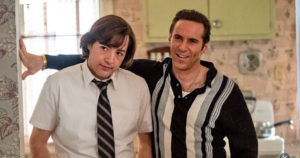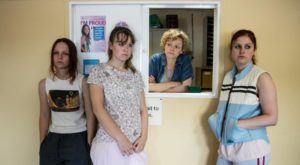I first heard about Grey’s Anatomy on the school bus. I’m turning 32 this week, and Grey’s is turning 20. It was the spring of 2005, when ABC launched this two-decade medical drama about the life and times of Dr. Meredith Grey and her colleagues at Seattle Grace Mercy West Hospital. The other sixth-grade girls would hop on the bus after a new episode, abuzz with excitement over McDreamy and McSteamy. There is no way my parents were going to let me watch Grey’s, but the school bus was our water cooler, so from American Idol to Lost, you couldn’t avoid these shows even if you wanted to.
The arc of Grey’s is the arc of American television in more ways than one. From monoculture to micro-culture, from a time of shared institutional trust to one of reflexive distrust, you can see the shift from Dr. Meredith Grey’s primetime debut on a March night during George W. Bush’s second term, to the show’s post-Covid whimpers. The era of medical soaps and detective shows has given way to streaming juggernaut Taylor Sheridan’s more cynical, less gauzy renderings of American institutions.
Wikipedia’s synopsis for the pilot episode of Grey’s Anatomy describes it like this: “Meredith Grey wakes up after a one-night stand to start her first shift as a surgical intern. The first shift for Meredith and the new surgical interns … proves eventful and backbreaking. While working, Meredith realises that the man from her one-night stand is Dr. Derek Shepherd, her attending physician. Derek enlists the interns’ work to solve the case of a teenage-girl baton twirler who has seizures. Meredith and Cristina realise that she has an aneurysm that was burst by a fall”.
The plot is almost too perfect: a high-achieving woman in a major city — post 9/11 Seattle — shows up to work and finds out she slept with her new boss the night before. She solves problems with her colleagues.
Derek, of course, was played by Patrick Dempsey. Along with Pompeo and Katherine Heigl (who played Izzie Stevens), Grey’s launched stars who were inescapable throughout the aughts. Shonda Rhimes, creator and head writer of the show, started Shondaland — the name of her production company and her vast universe of TV series — thanks to the blockbuster success of Grey’s. “At her most prolific”, a writer for Time noted in 2022, “Rhimes was responsible for producing around 70 episodes of TV across up to four ABC dramas each year”. Rhimes’ career, like those of her female protagonists from Bridgerton to Scandal, is its own topic of fascination for culture writers tracking the rise and fall of #GirlBoss feminism and the crescendo of Peak Woke.
One trend is impossible to ignore: Rhimes began her career on ABC. By 2017, she’d moved to Netflix, like most younger people in her audience. When the deal was re-upped in 2021, Rhimes reportedly got somewhere between $300 to $400 million. Yet no individual show today has the power Grey’s enjoyed in 2005.
That May, the Grey’s season finale drew 22 million viewers. That’s higher than last year’s September presidential debate. It’s roughly the audience of a Sunday-night football game these days. It’s impressive for a fictional series to garner anywhere close to 10 million viewers; last week’s episode of Grey’s got 2.39 million.
Welcome to the micro-culture, where success is measured in single-digit ratings. This is good and bad news for consumers and artists. The good news is that consumers get more niche content, and artists are under less pressure to create content for literally everyone. The bad news: consumers get more niche content and artists are under less pressure to create content for literally everyone.
The contrast between Stephen Colbert and Johnny Carson illustrates the effect of this dynamic on popular culture. Colbert was the king of late-night TV during President Trump’s first term, despite being the least funny and most partisan guy in the game. Carson didn’t avoid politics, but he avoided alienating one side or the other. During Carson’s run, of course, NBC needed to maximise the appeal of his show to draw the most ad dollars it possibly could. During Colbert’s run, the way to win the rating game is to cultivate a niche base of loyal supporters — and a great way to do that is with culture-war fodder.
Rhimes, a prominent activist for Democrats in the Trump years, is still a woman of the monoculture. “I don’t like to be preached at, and I’m not interested in preaching”, she said in 2022, when preaching was Hollywood’s top currency. Yet Rhimes resigned from the Kennedy Center board in protest of Trump’s takeover last month. She told Time she pivoted from the cutthroat White House saga of Olivia Pope and Scandal to the fantasy world of Netflix favorite Bridgerton, “when it felt like the world had caught up to the stories we were telling”.
Pope had an abortion in 2015. On Grey’s, Cristina Yang got one in 2011. Rhimes, interestingly enough, told Vulture she “let go” of a similar plot line during the series’ first season amid objections from the network. Planned Parenthood has since credited Rhimes with helping to “Flip The Script On Abortion In Television”. By 2011, though, Rhimes’s audience for Grey’s had been cut nearly in half. The abortion episode pulled in about 10 million viewers, which wasn’t nothing for ABC but wasn’t 2005 either.
The highest-rated Grey’s episodes of all-time are somewhat infamous. The first episode in a two-part special that aired after the Super Bowl in 2006 managed to pull in nearly 40 million viewers. Its self-seriousness is so amusing to revisit now that a doctor’s 2022 reaction video to the episode has more than 7 million views. Entertainment Weekly described the plot like this: “After surgically removing a bomb from a man’s torso, Meredith Grey hands it over to defuser Dylan Young — and it blows up before he even makes it out of the [operating room]”. If you can even make it through that description without laughing, congratulations on clinging to your innocence.
Every once in a while, scenes from the special go viral on social media, evoking something like disbelief that we actually sat on the edge of our seats, snacking on Super Bowl scraps, watching Kyle Chandler (spoiler alert) get blown up by a torso bomb.
And yet. Taylor Sheridan’s universe is thriving. From Yellowstone and its many spinoffs to Tulsa King, the man is a machine — not unlike Shonda Rhimes. His shows are just as soapy.
If you had the good fortune of missing the viral scene from Sheridan’s new series Landman in which Billy Bob Thornton’s teenage daughter explains how she avoids getting pregnant when sleeping with her boyfriend (it’s a bold strategy), the drama is a reminder that Americans are still glued to soaps. Landman isn’t bad. Perhaps like the torso bomb, in the context of the full episode, the scene’s jaw-dropping levels of cringe actually flow more naturally — though Sheridan still writes women like they live perpetually in the opening scene of a pornography movie.
Sheridan’s universe, like Shonda’s, is pure soap. It’s soap for men, to be sure, but it’s soap nonetheless. And, with the exception of football, it’s the closest TV comes to monoculture now. We don’t have clean apples-to-apples metrics to compare the streaming era with what came before it, but Paramount says Landman reached around 15 million households in its first four weeks. That seems to be a record, though Sheridan’s projects routinely pull in big numbers.
Shonda versus Sheridan is a fascinating study in contrasts. Books could be filled with analyses of how each writer treats men and women, and how those choices reflect cultural shifts. (Rhimes presaged the #GirlBoss ascent, Sheridan presaged the male backlash). Rhimes shook up the procedural drama dominated by classics like Law & Order, ER, and Baby-Boomer favourite Blue Bloods.
Where Sheridan and Shonda are both masters in the high art of television drama, what’s changed in the culture from 2005 to now is Americans’ relationship to authority: doctors, law enforcement, politicians. According to Gallup’s annual tracker, trust in the medical system is down 12 points since Grey’s premiered. The same is true of trust in the police. Trust in the presidency is down 18 points, and trust in Congress, big business, and banks is hovering near record lows.
Rhimes got dark. Grey’s got dark. But her shows were fuzzier than Sheridan’s. Their edges were blunted by optimism and redemption. Sheridan’s universe is cynical. It’s undeniably gorgeous, capturing Yellowstone like Bierstadt, electrifying new generations with a lust for the American frontier. But his institutions are dark and corrupt, and his protagonists are rough. (And not in a one-night-stand-with-Patrick-Dempsey kind of way.) Their redemption arcs take much more work, if the audience can even get there with the characters.
Maybe Sheridan’s post-Trump soap operas are what Shonda’s were post-9/11. Yellowstone is the Shondaverse for a generation with lower institutional trust, that finds its catharsis in escapism committed to depicting people as they are, not as we want them to be. There are merits in both, to be sure, but as Grey’s hits the 20-year mark in a new economy and new culture, it’s funny to think our appetites for soap operas haven’t changed, but our appetites for their heroes have.
Disclaimer
Some of the posts we share are controversial and we do not necessarily agree with them in the whole extend. Sometimes we agree with the content or part of it but we do not agree with the narration or language. Nevertheless we find them somehow interesting, valuable and/or informative or we share them, because we strongly believe in freedom of speech, free press and journalism. We strongly encourage you to have a critical approach to all the content, do your own research and analysis to build your own opinion.
We would be glad to have your feedback.
Source: UnHerd Read the original article here: https://unherd.com/






